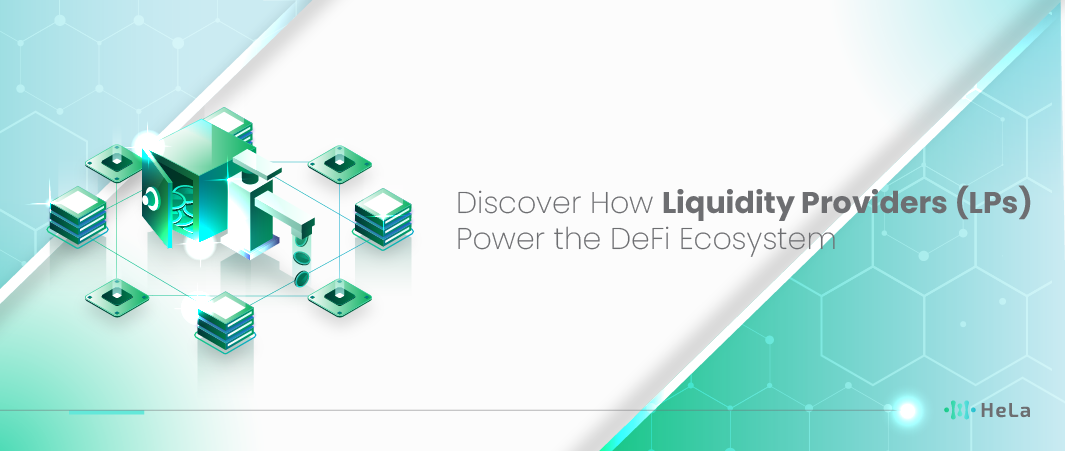How Liquidity Providers Work in the DeFi Ecosystem are crucial to the functionality of decentralized finance (DeFi) platforms, playing a pivotal role by supplying assets to liquidity pools on decentralized exchanges (DEXs). By depositing their tokens into these pools, LPs enable smooth and efficient trading, as these pools facilitate the exchange of cryptocurrencies without the need for traditional intermediaries. In return for their contribution, LPs earn rewards from transaction fees and additional incentives such as governance tokens. Understanding the mechanics of how LPs work, including the potential risks and rewards, is essential for anyone looking to participate in the growing DeFi space.
In this article, we delve into the various types of Liquidity Providers, from retail and institutional to passive and active participants. We will explore how these providers earn crypto, the strategies they employ, and the risks they face, including impermanent loss. Whether you are an individual investor or a financial institution, grasping these concepts will help you make informed decisions and optimize your involvement in DeFi. Read on to gain a comprehensive understanding of Liquidity Providers and their impact on the DeFi ecosystem.
What is Liquidity Provider in Crypto?

A Liquidity Provider (LP) is an individual or entity that supplies funds to a liquidity pool on decentralized finance (DeFi) platforms. A liquidity pool is a collection of assets used by decentralized exchanges (DEX) to facilitate trades without intermediaries. LPs provide assets like Ethereum or stablecoins to these pools, which are then used by traders to swap assets. In return, LPs earn a small percentage of the transaction fees generated from trading activities in the pool.
This concept is crucial because it ensures that DEX platforms always have enough assets to allow traders to transact at any time. With high liquidity, trades can be executed quickly and with minimal slippage (the price difference between when an order is placed and when it is executed). Without Liquidity Providers, a DEX would struggle to provide an efficient market and risk significant price differences, which could harm users.
Also Read: Top 10 Crypto Exchange Liquidity Providers in 2024
Becoming an LP is not without risks. One of the main risks LPs face is impermanent loss, which occurs when the value of assets deposited in the pool decreases compared to simply holding the assets in a wallet. This happens when there is a significant price movement between the two assets in the pool. However, despite this risk, the potential rewards from transaction fees are often appealing to many investors, especially if they believe in the long-term prospects of the assets they are providing.
Overall, Liquidity Providers are the backbone of the DeFi ecosystem, ensuring liquidity is available for trading on DEXs. As DeFi becomes more popular, the role of LPs grows increasingly important, supporting decentralization and providing an alternative to traditional centralized exchanges. For those interested in becoming an LP, it’s essential to understand the risks and potential rewards, as well as conduct thorough research before supplying liquidity to a specific pool.
Types of Liquidity Providers

Liquidity Providers (LPs) come in various types, each with distinct strategies, objectives, and roles within the decentralized finance (DeFi) ecosystem. These types cater to different levels of expertise, risk tolerance, and capital. By understanding the nuances of each type, both individuals and institutions can better navigate the complexities of liquidity provision in DeFi. Here are some of the most common types of Liquidity Providers:
Retail Liquidity Providers
Retail LPs are typically individual investors who provide liquidity using their personal funds. These participants usually engage with decentralized exchanges (DEXs) such as Uniswap, SushiSwap, or PancakeSwap. Retail LPs deposit equal amounts of two tokens into a liquidity pool, facilitating trades between them.
In return, they earn a share of the trading fees generated by the pool. While the barrier to entry is relatively low, retail LPs often face challenges such as impermanent loss, which can erode their profits if the prices of the tokens they provide diverge significantly. Retail LPs may also lack advanced tools for monitoring and managing their positions, making them more vulnerable to market volatility.
Institutional Liquidity Providers
Institutional LPs include large financial entities like hedge funds, asset management firms, or proprietary trading desks. These institutions have access to significant capital and often provide large sums of liquidity to various pools.
Institutional LPs typically engage in more sophisticated strategies, such as arbitrage, where they exploit price differences across multiple platforms, or market-making, where they provide continuous buy and sell orders to facilitate trading. With access to advanced analytics, algorithms, and risk management tools, institutional LPs are better equipped to minimize risks like impermanent loss and optimize their returns. Their participation in DeFi adds substantial liquidity to the markets, making them critical players in the ecosystem.
Passive Liquidity Providers
Passive LPs adopt a long-term approach to liquidity provision. These participants are often attracted to platforms that offer automated strategies and protections against risks like impermanent loss. Platforms such as Yearn Finance and Bancor provide mechanisms that optimize yield and minimize risks without requiring constant intervention.
Passive LPs prefer a hands-off approach, depositing their assets and letting the smart contracts handle the rest. This type of liquidity provision is appealing to those who want to earn consistent returns over time without the need for active management. However, passive LPs must be comfortable with leaving their assets locked in liquidity pools for extended periods, as pulling out liquidity prematurely can impact their overall returns.
Active Liquidity Providers
In contrast to passive LPs, active liquidity providers are highly engaged with their positions. They continuously monitor the market and adjust their liquidity based on changing conditions. Active LPs might rebalance their portfolios to avoid impermanent loss, withdraw liquidity during periods of high volatility, or even leverage their assets to amplify potential gains.
This type of LP requires a deep understanding of DeFi protocols, market trends, and liquidity dynamics. Active LPs are often more experienced and willing to take on higher risks in exchange for potentially higher rewards. The downside is that this approach demands constant attention and decision-making, which can be time-consuming and mentally taxing.
How Does Liquidity Provider Works?

Liquidity Providers (LPs) work by depositing assets into a liquidity pool on a decentralized exchange (DEX). These pools are collections of funds that allow traders to swap between different cryptocurrencies without relying on a traditional order book. When you become an LP, you contribute a pair of tokens (e.g., ETH and USDT) in equal value to the pool. These assets then become available for traders who wish to exchange one asset for the other, with the smart contract automatically handling the transactions.
Also Read: What is Exit Liquidity and Why Does It Matter?
The mechanics of a liquidity pool are governed by an automated market maker (AMM) algorithm, which uses mathematical formulas to determine the price of assets in the pool based on their relative supply. As traders make swaps, the balance of the assets in the pool changes, causing the price to adjust. LPs earn a share of the fees generated by these trades, typically a small percentage of each transaction, which is proportionate to their contribution to the pool. This means that the more trading activity there is in the pool, the more fees LPs can potentially earn.
However, liquidity provision comes with risks, particularly impermanent loss. Impermanent loss occurs when the price ratio of the two assets in the pool changes, resulting in the LP holding a different amount of each asset than they initially deposited. If the price difference is significant, the total value of the LP’s assets in the pool may be lower than if they had simply held onto their tokens. While LPs can still earn fees to offset this loss, it is important to monitor price movements and pool dynamics to manage risks effectively.
In essence, LPs play a critical role in maintaining the liquidity and efficiency of DEXs. By supplying assets to these pools, they enable seamless trading for users while earning passive income through transaction fees. The process is decentralized and automated, meaning that once assets are deposited, the smart contract manages everything. Nonetheless, LPs must be aware of market conditions and the potential risks involved to maximize their rewards and minimize losses.
Earning Crypto as A Liquidity Provider
Earning crypto as a Liquidity Provider (LP) involves supplying liquidity to decentralized exchanges (DEXs) or other DeFi protocols, where your assets enable smooth trading operations. In return, you earn rewards, typically in the form of transaction fees, governance tokens, or even yield farming incentives. When you contribute assets to a liquidity pool, you’re helping facilitate the exchange of tokens on that platform. Every time a trader uses the pool to swap tokens, they pay a fee, which is distributed proportionally among all the LPs in that pool. This fee structure makes liquidity provision an attractive source of passive income, especially during periods of high trading volume.
The earnings potential for LPs depends on several factors, including the trading volume in the pool, the fee percentage, and the size of the LP’s contribution relative to the total pool. Pools with high trading activity, such as those involving popular tokens like Ethereum or stablecoins, tend to generate more fees, resulting in higher returns for LPs. However, it’s important to note that competition can dilute your earnings. In a large pool with many LPs, your share of the fees will be smaller, so choosing the right pool and timing your liquidity provision is crucial to maximizing returns.
In addition to transaction fees, many DeFi platforms offer additional incentives for LPs through yield farming or liquidity mining programs. These programs reward LPs with the platform’s native tokens or other crypto assets, often at attractive annual percentage yields (APYs). For example, protocols like SushiSwap or PancakeSwap may distribute governance tokens as rewards, giving LPs not only extra income but also voting power in the platform’s decision-making process. Yield farming can significantly boost earnings, but it also introduces additional risks, such as the volatility of the reward tokens and the potential for impermanent loss.
While earning crypto as an LP can be profitable, it comes with risks that must be managed. Impermanent loss occurs when the value of the assets you’ve deposited fluctuates significantly, leading to a potential loss when you withdraw your funds compared to if you had simply held the tokens. To mitigate this, many LPs choose to provide liquidity in pools that involve stablecoins, which are less volatile than other cryptocurrencies. Additionally, platforms with impermanent loss protection mechanisms, like Bancor, can help safeguard your assets. Ultimately, understanding the balance between potential earnings and risks is key to successfully earning crypto as a Liquidity Provider.
Conclusion
Understanding how Liquidity Providers (LPs) work in the DeFi ecosystem is fundamental to grasping their pivotal role in decentralized finance. LPs enhance the functionality of decentralized exchanges (DEXs) by supplying assets to liquidity pools, which facilitates smooth and efficient trading without the need for traditional intermediaries.
In exchange for their contributions, LPs earn rewards from transaction fees and additional incentives, such as governance tokens. However, the potential for earning comes with inherent risks, including impermanent loss, which can impact the value of the assets provided. This comprehensive understanding of LP dynamics is crucial for making informed decisions and optimizing one’s involvement in the DeFi space.
In conclusion, the diverse types of LPs—ranging from individual retail investors to large institutional players, and from passive to active participants—each bring unique benefits and challenges to the DeFi ecosystem. Retail LPs often engage in a more hands-on approach with smaller investments, while institutional LPs leverage significant capital and advanced strategies.
Passive LPs prefer a long-term, less active role, whereas active LPs continuously manage their positions to maximize returns. By delving into these roles, their earnings potential, and associated risks, individuals and institutions alike can better navigate and succeed in the evolving world of decentralized finance. This knowledge empowers LPs to strategically participate, enhance their financial outcomes, and effectively manage the risks inherent in liquidity provision.
Disclaimer: The information provided by HeLa Labs in this article is intended for general informational purposes and does not reflect the company’s opinion. It is not intended as investment advice or a recommendation. Readers are strongly advised to conduct their own thorough research and consult with a qualified financial advisor before making any financial decisions.

